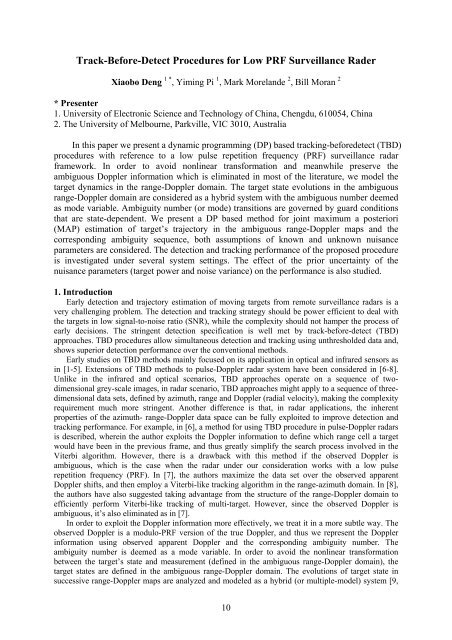Workshop proceeding - final.pdf - Faculty of Information and ...
Workshop proceeding - final.pdf - Faculty of Information and ...
Workshop proceeding - final.pdf - Faculty of Information and ...
You also want an ePaper? Increase the reach of your titles
YUMPU automatically turns print PDFs into web optimized ePapers that Google loves.
Track-Before-Detect Procedures for Low PRF Surveillance Rader<br />
Xiaobo Deng 1 * , Yiming Pi 1 , Mark Morel<strong>and</strong>e 2 , Bill Moran 2<br />
* Presenter<br />
1. University <strong>of</strong> Electronic Science <strong>and</strong> Technology <strong>of</strong> China, Chengdu, 610054, China<br />
2. The University <strong>of</strong> Melbourne, Parkville, VIC 3010, Australia<br />
In this paper we present a dynamic programming (DP) based tracking-beforedetect (TBD)<br />
procedures with reference to a low pulse repetition frequency (PRF) surveillance radar<br />
framework. In order to avoid nonlinear transformation <strong>and</strong> meanwhile preserve the<br />
ambiguous Doppler information which is eliminated in most <strong>of</strong> the literature, we model the<br />
target dynamics in the range-Doppler domain. The target state evolutions in the ambiguous<br />
range-Doppler domain are considered as a hybrid system with the ambiguous number deemed<br />
as mode variable. Ambiguity number (or mode) transitions are governed by guard conditions<br />
that are state-dependent. We present a DP based method for joint maximum a posteriori<br />
(MAP) estimation <strong>of</strong> target’s trajectory in the ambiguous range-Doppler maps <strong>and</strong> the<br />
corresponding ambiguity sequence, both assumptions <strong>of</strong> known <strong>and</strong> unknown nuisance<br />
parameters are considered. The detection <strong>and</strong> tracking performance <strong>of</strong> the proposed procedure<br />
is investigated under several system settings. The effect <strong>of</strong> the prior uncertainty <strong>of</strong> the<br />
nuisance parameters (target power <strong>and</strong> noise variance) on the performance is also studied.<br />
1. Introduction<br />
Early detection <strong>and</strong> trajectory estimation <strong>of</strong> moving targets from remote surveillance radars is a<br />
very challenging problem. The detection <strong>and</strong> tracking strategy should be power efficient to deal with<br />
the targets in low signal-to-noise ratio (SNR), while the complexity should not hamper the process <strong>of</strong><br />
early decisions. The stringent detection specification is well met by track-before-detect (TBD)<br />
approaches. TBD procedures allow simultaneous detection <strong>and</strong> tracking using unthresholded data <strong>and</strong>,<br />
shows superior detection performance over the conventional methods.<br />
Early studies on TBD methods mainly focused on its application in optical <strong>and</strong> infrared sensors as<br />
in [1-5]. Extensions <strong>of</strong> TBD methods to pulse-Doppler radar system have been considered in [6-8].<br />
Unlike in the infrared <strong>and</strong> optical scenarios, TBD approaches operate on a sequence <strong>of</strong> twodimensional<br />
grey-scale images, in radar scenario, TBD approaches might apply to a sequence <strong>of</strong> threedimensional<br />
data sets, defined by azimuth, range <strong>and</strong> Doppler (radial velocity), making the complexity<br />
requirement much more stringent. Another difference is that, in radar applications, the inherent<br />
properties <strong>of</strong> the azimuth- range-Doppler data space can be fully exploited to improve detection <strong>and</strong><br />
tracking performance. For example, in [6], a method for using TBD procedure in pulse-Doppler radars<br />
is described, wherein the author exploits the Doppler information to define which range cell a target<br />
would have been in the previous frame, <strong>and</strong> thus greatly simplify the search process involved in the<br />
Viterbi algorithm. However, there is a drawback with this method if the observed Doppler is<br />
ambiguous, which is the case when the radar under our consideration works with a low pulse<br />
repetition frequency (PRF). In [7], the authors maximize the data set over the observed apparent<br />
Doppler shifts, <strong>and</strong> then employ a Viterbi-like tracking algorithm in the range-azimuth domain. In [8],<br />
the authors have also suggested taking advantage from the structure <strong>of</strong> the range-Doppler domain to<br />
efficiently perform Viterbi-like tracking <strong>of</strong> multi-target. However, since the observed Doppler is<br />
ambiguous, it’s also eliminated as in [7].<br />
In order to exploit the Doppler information more effectively, we treat it in a more subtle way. The<br />
observed Doppler is a modulo-PRF version <strong>of</strong> the true Doppler, <strong>and</strong> thus we represent the Doppler<br />
information using observed apparent Doppler <strong>and</strong> the corresponding ambiguity number. The<br />
ambiguity number is deemed as a mode variable. In order to avoid the nonlinear transformation<br />
between the target’s state <strong>and</strong> measurement (defined in the ambiguous range-Doppler domain), the<br />
target states are defined in the ambiguous range-Doppler domain. The evolutions <strong>of</strong> target state in<br />
successive range-Doppler maps are analyzed <strong>and</strong> modeled as a hybrid (or multiple-model) system [9,<br />
10
















